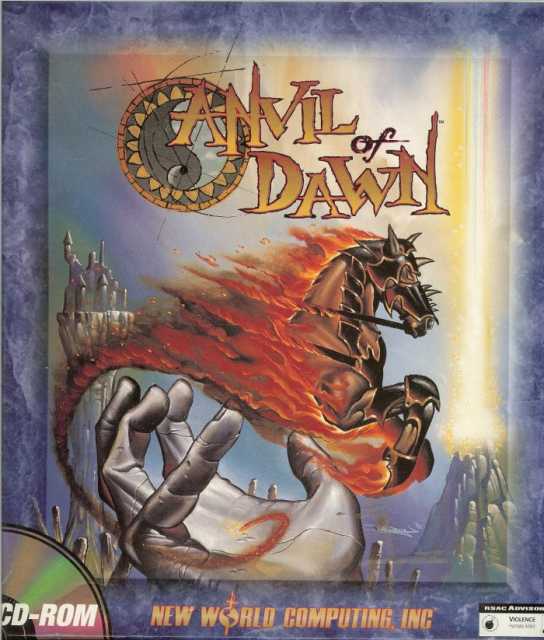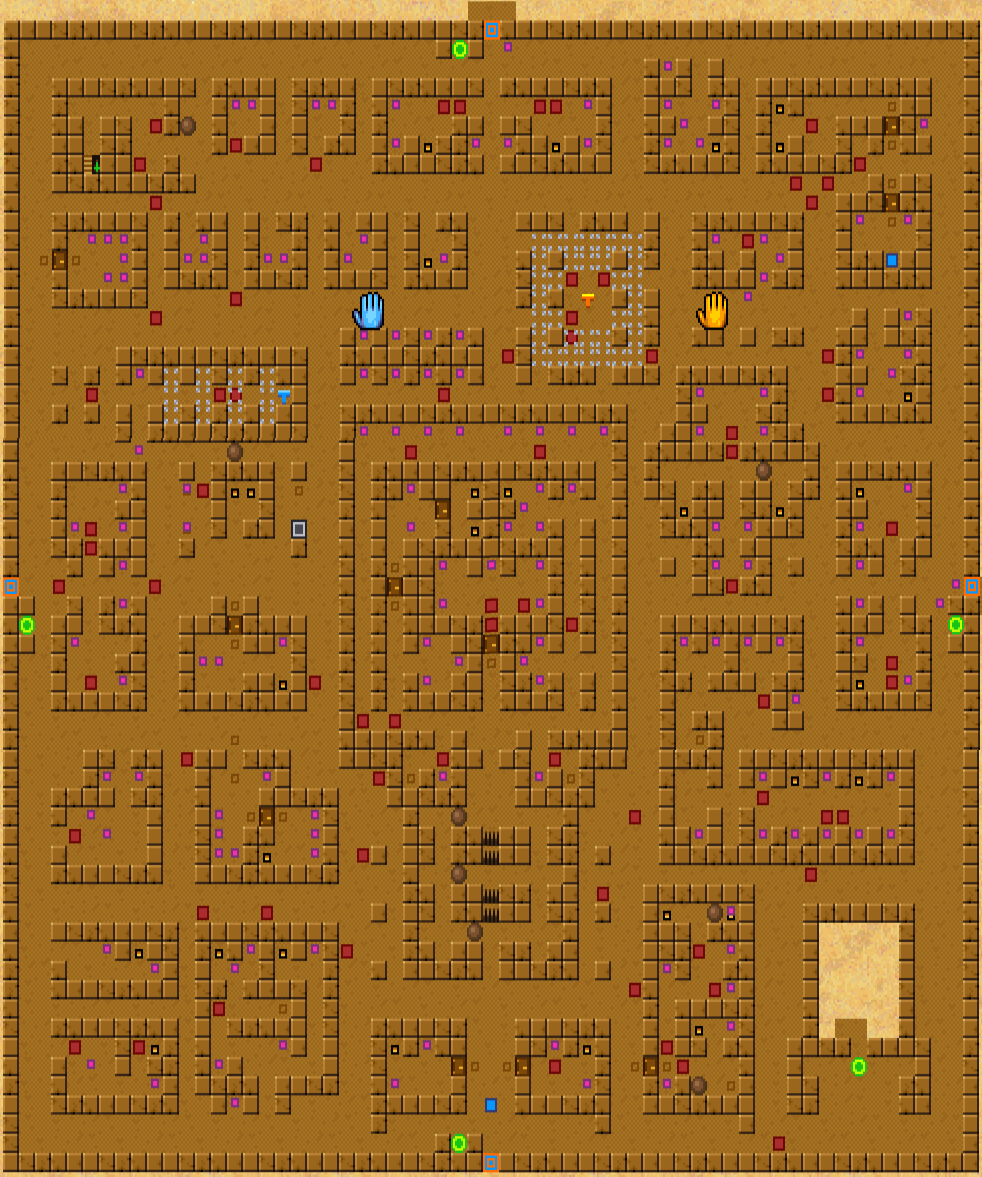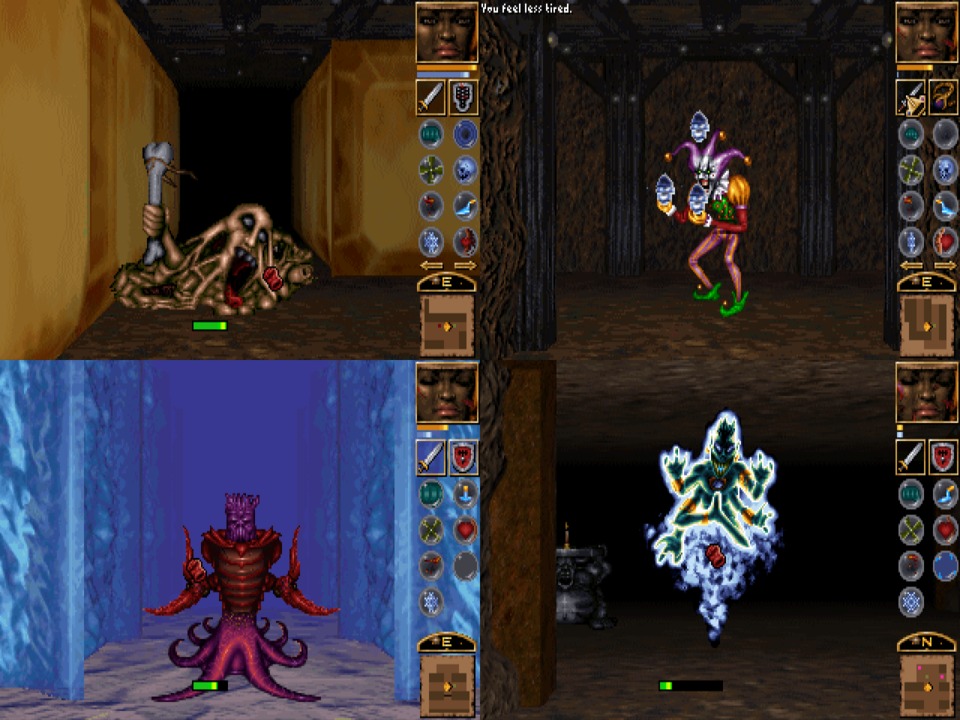May Maturity 12: Anvil of Dawn (Outro)
By Mento 2 Comments

Sorry to end this year's May Maturity on a bummer, but I had to bounce from Anvil of Dawn also. The developers of this game really could've benefited from a better sense of conciseness. After the promising initial dungeon of Gryphon's Keep, which had a few clever if somewhat incongruous traps for a keep that was theoretically built to house guards, and a sizeable first floor that broke off into smaller towers, the rest of the game then became this procession of absolutely enormous 60x60 grid dungeon floors with the same assortment of traps and puzzles repeated ad nauseum. By the point I was at - exploring a big ol' underground root system that had new types of walls and monsters but all the same teleporters and pressure plates - the sound decided to completely crap out on me, going from the slightly staticky voice samples and passable MIDI music it had previously to something you'd hear from a radio that had been dunked underwater a few times. Pleasant but unremarkable DOS-era sound warped into a dial-up modem being fed through a woodchipper. I wasn't able to ascertain what had caused the sound quality to dip - which cannot be turned off, by the way, only minimized to a whisper, but ambient sound is a very important aspect for first-person RPGs regardless - but I'd also decided during the troubleshooting process that I didn't really care enough to try and save the playthrough.
Dungeon Master, which is really the Ur example of this particular sort of puzzles n' pugnacity first-person dungeon crawler that every subsequent game of its very specific formula has tried to imitate to varying degrees, presented its players with a relatively focused adventure where each floor had a certain level of personality, as well as its own enemies and iconography. We weren't quite at a place in 1987 where you could theme each area with wildly varying art styles like Anvil of Dawn can boast, from its brick walls to underwater channels to volcanoes, but you only needed to play Dungeon Master a few times to recall that, yes, Level 3 was the one with all the clever isolated puzzle rooms to solve, Level 4 was the tough one with all the red worms, and Level 6 was the big maze with the plot-vital Firestaff in the center which you'd only be able to reach after killing the red dragon boss on Level 13. Anvil of Dawn retains some of that differentiation, to an extent, but each of its zones is so massive and filled with so many repeating and ultimately superfluous challenges that even though it tossed you these great looking areas and new enemies, it all started to become very familiar before too long. There's more to creating personality for a game beyond a neat aesthetic, it turns out.
Also, a 60x60 grid doesn't sound too big just hearing it abstractly like this, so maybe it'd be easier to think of it as 3600 squares. For a single floor. In a game with a dozen dungeons, each of which has at least two floors. There are no "small" dungeons to break up the big bastards either that I encountered; nothing that would serve as a breather between the story-important dungeons that might've necessitated a larger playing field. The closest to a mini-dungeon was the sunken ship, but even that had two fairly large floors and nothing but zombie sailors to fight. The way the game sets itself up is that you need many components to create a magical box that can contain the powerful and evil magic source McGuffin that the game's warlord antagonist is using to conquer the world: every dungeon then becomes an essential port of call, each with a special component item at the end that might involve solving a puzzle or two (one, the heartstone to adorn the front of the box, required running through a mine maze with magic-draining zones to look for a glowing rock in the walls). To be clear, I don't fault the game's unique, dungeon-specific puzzles: that's the good shit, the sort of inventive level design-focused brain-teasers that, in my view, can often elevate these frequently brainless dungeon crawlers. It's the same principle behind The Legend of Zelda and its enduring popularity, despite the fact that its puzzles tend to revolve around a familiar set of equipment. The chief flaw of Anvil of Dawn's level design is that every dungeon's creation also insisted on five handfuls from the "generic traps n' obstacles" box on top of it to fill out the ludicrous amount of real estate. A single dungeon full of teleport traps would be fine, if that happened to be the theme for that location, but instead they all have teleporters. And pressure plates. And spinners which messed around with your movement. And spells flying down corridors that you have to dodge. And rumbling boulders which occupy the same role, only they occasionally got stuck in game-breaking ways. And zones which drain your magic so you can't heal, or sap your strength so you can't carry stuff.

Speaking of which, something else I was getting fed up with was constantly managing my inventory. One of the few unusual traits that Dungeon Master had among RPGs of its era - that almost every game of its type also feels it has to adopt - is the lack of any kind of economy. You can't replenish basic supplies or sell off items you no longer need for cash you could then put towards something you would need. You can pick up new weapons and armor - and to Anvil of Dawn's credit, it'll actually tell you what kind of damage you can do with those weapons and how much damage that armor will negate - but the game doesn't let you upgrade your equipment too often, and instead frequently sticks these linear iterative upgrades in chests behind secret walls or some such. Worst of all, your stack of supplies is made finite by an encumbrance limit, and it's not always clear which areas are easy to return to if you decided to leave caches behind. The Underground City has a lot of exits, suggesting you'll come back that way frequently, but it still means dumping items you might end up needing before you have a chance to return, and you can never guarantee that you'll find enough new items of that type going forward. As one of those overly cautious types who ends every Final Fantasy game with a stockpile of fifty Megalixirs, leaving a potentially finite supply of healing items behind because I'm too laden down with plot-vital keys or the increasingly heavy upgrades to my gear doesn't really entice. That I can't sell those excess goods or buy items I might be running low on is just the cherry on the top of that particular poop sundae.
I want to say that, like The Feeble Files last time, I still have enough goodwill for this specific sub-genre that I'm sure it's just a case of encountering a bad (or, perhaps in this case, badly aged) entry rather than growing enervated by the entire format. I loved The Legend of Grimrock 2 (from 2014) and how it made up for the shortcomings of the previous game with a fresh new approach, I liked StarCrawlers (from 2017) and how it was a rare sci-fi variant with a somewhat engaging procedural generation aspect, and I'm sure I'll enjoy the steampunk-themed Vaporum when I eventually get around to it either this year or next. Dungeon Master and Lands of Lore: The Throne of Chaos remain firm favorites of mine to this day, though I am slightly apprehensive about revisiting them again now (whatever, I played Dungeon Master a few years ago and it still rocked me). For that matter, I had a great time with Ultima Underworld II and Might and Magic: World of Xeen, and those were just earlier this month. I think what Anvil of Dawn represents (and The Feeble Files too in its own respective way) is that genre at its most unnecessarily excessive, greatly amplifying the genre tropes that usually don't work for me or were more tolerable in smaller doses, as well as being too long and convoluted and tiresome in general. That's opposed to the smart, compactly-made nonpareils that inspired them, and the smart, compactly-made present day incarnations from Indie developers who keenly understood the former and were able to replicate that joy for a modern audience. I guess some games are just destined to be also-rans who didn't fully "get it".

And with that, May Maturity draws to a close this year. With what evidently amounted to some slim pickings for 2018, I'm clearly going to have to retool this feature again for 2019. I have some notions, but right now the big analog decision is choosing between going even more random, getting back to the spirit of the original May Madness at the possible expense of encountering more duffers, or casting a wider net for all those "bucket list" games I've been meaning to catch up on for many years. No reason to stick to just the 1990s, is all I'm saying there.
At any rate, thanks for joining me on another journey through medieval PC gaming history, and apologies for bailing on so many of them this year. I'm sure it's the games' fault and not mine. Pretty sure.
